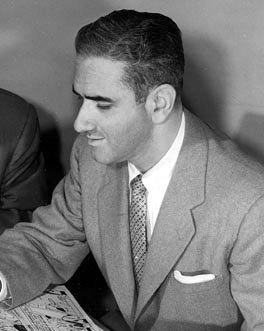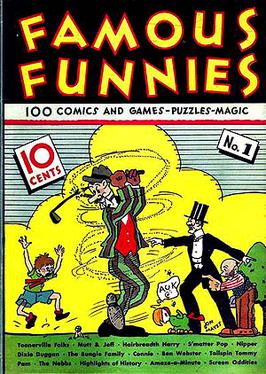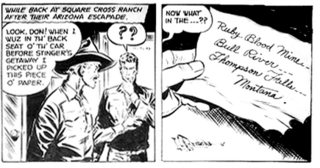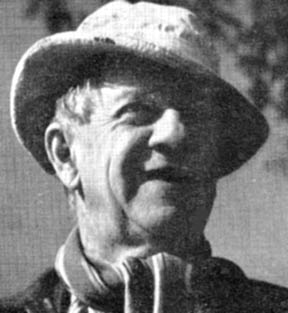Related Research Articles
United Feature Syndicate, Inc. (UFS) is a large American editorial column and comic strip newspaper syndication service based in the United States and established in 1919. Originally part of E. W. Scripps Company, it was part of United Media from 1978 to 2011, and is now a division of Andrews McMeel Syndication. United Features has syndicated many notable comic strips, including Peanuts, Garfield, Li'l Abner, Dilbert, Nancy, and Marmaduke.

The Funnies was the name of two American publications from Dell Publishing, the first of these a seminal 1920s precursor of comic books, and the second a standard 1930s comic book.

Bob Oksner was an American comics artist known for both adventure comic strips and for superhero and humor comic books, primarily at DC Comics.
Star Hawks was a comic strip created by Ron Goulart and Gil Kane, first published on October 3, 1977, that ran through May 2, 1981. It was written through April 1979 by Goulart, followed by Archie Goodwin (1979-1980), Roger McKenzie (1980-1981) and Roger Stern. Comics veteran Gil Kane provided the artwork, with uncredited help from Ernie Colón and Howard Chaykin.

Reg'lar Fellers is a long-running newspaper comic strip adapted into a feature film, a radio series on the NBC Red Network, and two animated cartoons. Created by Gene Byrnes (1889–1974), the comic strip offered a humorous look at a gang of suburban children. Syndicated from 1917 to January 18, 1949, Byrnes' strip was collected into several books. Branding also extended to such items as baseball bats and breakfast cereal.
The Eastern Color Printing Company was a company that published comic books, beginning in 1933. At first, it was only newspaper comic strip reprints, but later on, original material was published. Eastern Color Printing was incorporated in 1928, and soon became successful by printing color newspaper sections for several New England and New York papers. Eastern is most notable for its production of Funnies on Parade and Famous Funnies, two publications that gave birth to the American comic book industry.

Gordon G. Rogers, better known as Boody Rogers, was an American comic strip and comic book cartoonist who created the superhero parody Sparky Watts.

Funnies on Parade is an American giveaway publication of 1933 that was a precursor of comic books. The eight-page publication featured reprints of such popular syndicated comic strips as The Bungle Family, Joe Palooka, Keeping Up with the Joneses, Mutt and Jeff, Reg'lar Fellers, and Somebody's Stenog. Creators included F. O. Alexander, Gene Byrnes, Al Capp, Clare Victor Dwiggins, A. E. Hayward, C. M. Payne, Al Smith, and Harry J. Tuthill.

Famous Funnies is an American comic strip anthology series published from 1934 to 1955 with two precursor one-shots appearing in 1933–1934. Published by Eastern Color Printing, Famous Funnies is considered by popular culture historians as the first true American comic book, following seminal precursors.
A comic strip syndicate functions as an agent for cartoonists and comic strip creators, placing the cartoons and strips in as many newspapers as possible on behalf of the artist. A syndicate can annually receive thousands of submissions, from which only two or three might be selected for representation. In some cases, the work will be owned by the syndicate as opposed to the creator. The Guinness World Record for the world's most syndicated strip belongs to Jim Davis' Garfield, which at that point (2002) appeared in 2,570 newspapers, with 263 million readers worldwide.

The McNaught Syndicate was an American newspaper syndicate founded in 1922. It was established by Virgil Venice McNitt and Charles V. McAdam. Its best known contents were the columns by Will Rogers and O. O. McIntyre, the Dear Abby letters section and comic strips, including Joe Palooka and Heathcliff. It folded in September 1989.

Don Winslow of the Navy was an American comic strip created by Frank Victor Martinek and distributed mostly by the Bell Syndicate from 1934 to 1955. The title character was a spy-chasing lieutenant commander in Naval intelligence. The comic strip led to a radio adventure serial that began in 1937, as well as film serials that began in 1942. Original comic book stories also appeared in Fawcett Comics titles starting in 1943.

Clare Victor Dwiggins was an American cartoonist who signed his work Dwig. Dwiggins created a number of comic strips and single-panel cartoons for various American newspapers and newspaper syndicates from 1897 until 1945, including his best-known strip, the long-running School Days.

Gladys Parker was an American cartoonist for comic strips and a fashion designer in Hollywood. She is best known as the creator of the comic strip Mopsy (1929-1965), which had a long run over three decades. Parker was one of the few female cartoonists working between the 1930s and 1950s.

McClure Newspaper Syndicate, the first American newspaper syndicate, introduced many American and British writers to the masses. Launched in 1884 by publisher Samuel S. McClure, it was the first successful company of its kind. It turned the marketing of comic strips, columns, book serials and other editorial matter into a large industry, and a century later, 300 syndicates were distributing 10,000 features with combined sales of $100 million a year.
The Bell Syndicate, launched in 1916 by editor-publisher John Neville Wheeler, was an American syndicate that distributed columns, fiction, feature articles and comic strips to newspapers for decades. It was located in New York City at 247 West 43rd Street and later at 229 West 43rd Street. It also reprinted comic strips in book form.
The Public Ledger Syndicate was a syndication company operated by the Philadelphia Public Ledger that was in business from 1915 to circa 1950. The Ledger Syndicate distributed comic strips, panels, and columns to the United States and the United Kingdom, Ireland, Canada, Sweden, New Zealand, and Australia. The syndicate also distributed material from the Curtis Publishing Company's other publications, including The Saturday Evening Post, Ladies' Home Journal, and The Country Gentleman.
The New York Herald Tribune Syndicate was the syndication service of the New York Herald Tribune. Syndicating comic strips and newspaper columns, it operated from c. 1914 to 1966. The syndicate's most notable strips were Mr. and Mrs., Our Bill, Penny, Miss Peach, and B.C. Syndicated columns included Walter Lippmann's Today and Tomorrow, Weare Holbrook's Soundings, George Fielding Eliot's military affairs column, and John Crosby's radio and television column. Irita Bradford Van Doren was book review editor for a time.
The Frank Jay Markey Syndicate was a small print syndication service that distributed comic strips and columns from the mid-1930s to c. 1950. Although small in size, the syndicate distributed strips by a number of notable cartoonists, including Ed Wheelan, Rube Goldberg, Boody Rogers, and Frank Borth. The syndicate also provided material for the burgeoning comic book industry, for companies like Quality Comics and Columbia Comics.
The New York World was one of the first newspapers to publish comic strips, starting around 1890, and contributed greatly to the development of the American comic strip. Notable strips that originated with the World included Richard F. Outcault's Hogan's Alley, Rudolph Dirks' The Captain and the Kids, Denys Wortman's Everyday Movies, Fritzi Ritz, Gus Mager's Hawkshaw the Detective, Victor Forsythe's Joe Jinks, and Robert Moore Brinkerhoff's Little Mary Mixup.
References
- 1 2 Saunders, David. "SAMUEL S. McCLURE (1857-1949)," Field Guide to Wild American Pulp Artists. Accessed Nov. 1, 2018.
- ↑ "McClure Publishing Company: Archives: Historical and Biographical Note," University of Delaware Library Special Collections Department website. Accessed Nov. 1, 2018.
- ↑ Fourth Estate: A Weekly Newspaper for Publishers, Advertisers, Advertising Agents and Allied Interests (Fourth Estate Publishing Company, May 2, 1914), p. 17.
- ↑ Kemp, Bill. "A page from our past: Local minister became well-known newspaper columnist," The Pantagraph (Mar. 18, 2018).
- ↑ Holtz, Allan. "Mystery Strip Update: Frank Moser's Panel Cartoon Series," Strippper's Guide (September 15, 2015).
- ↑ Thompson, Neal. A Curious Man: The Strange & Brilliant Life of Robert "Believe It Or Not!" Ripley (Crown/Archetype, 2014), p. 115.
- 1 2 Markstein, Don (2006). "Miss Cairo Jones". Don Markstein's Toonopedia. Archived from the original on April 14, 2012.
- ↑ "Funnies on Parade," Grand Comics Database. Accessed Oct. 29, 2018.
- ↑ Brown, Mitchell. "The 100 Greatest Comic Books of the 20th Century: Funnies on Parade". Archived from the original on 2003-02-24. Retrieved 2003-02-24.
- ↑ Goulart, Ron (2004). Comic Book Encyclopedia. New York: Harper Entertainment. ISBN 978-0060538163.
- ↑ Goulart, Ron. "The Funnies: I" (entry), Comic Book Encyclopedia (Harper Entertainment, New York, 2004) ISBN 0-06-053816-3, p. 144
- ↑ Reynolds, Moira Davison. "Comic Strip Artists," Comic Strip Artists in American Newspapers, 1945-1980 (McFarland, 2003), p. 114.
- ↑ Markstein, Donald D. (2007). "Mopsy". Don Markstein's Toonopedia. toonopedia.com. Retrieved June 19, 2016.
- 1 2 3 Markstein, Don. "Reg'lar Fellers," Toonpedia. Accessed Nov. 1, 2018.
- ↑ Sinnott entry, Lambiek's Comiclopedia. Accessed Nov. 1, 2018.
- ↑ Allen, Stookie (April 21, 1950). "Keen Teen: Lens Lad, Paul Nielsen". The Miami News. Retrieved 25 August 2012.
- ↑ O'Mealia entry, Who's Who of American Comic Books 1928–1999. Accessed Nov. 1, 2018.
- 1 2 O'Mealia entry, Lambiek's Comiclopedia. Accessed Nov. 1, 2018.
- ↑ Albert entry, Who's Who of American Comic Books 1928–1999. Accessed Nov. 1, 2018.
- ↑ Oksner entry, Who's Who of American Comic Books 1928–1999. Accessed Nov. 1, 2018.
- ↑ "Miss Cairo Jones, by Bob Oksner", in Ron Goulart's Comics History Magazine No. 2, Winter 1996 (pp.16-17)
- ↑ George Carlson entry, Who's Who of American Comic Books 1928–1999. Accessed Nov. 1, 2018.